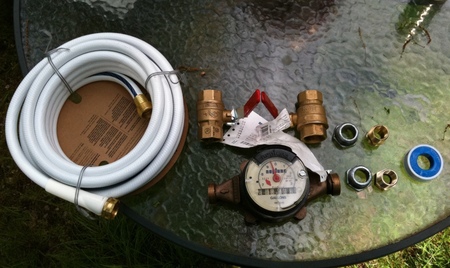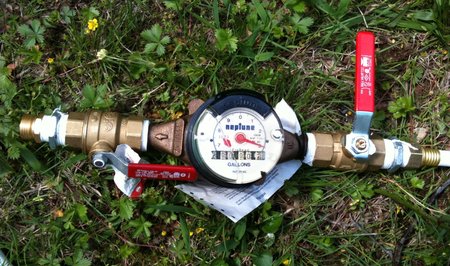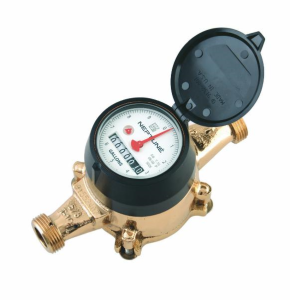The biggest problem I’ve had to date with my brew system is water management. When you do partial boils, this problem never rears its head – you brew a few gallons of wort and just top off with water to get to your final volume. Easy peasy. When you start doing all grain mashes and full boils, however, you need to back into the amount of water to use, taking all sorts of factors into consideration. What is your evaporation rate during the boil? How much water does your grain absorb? What about cooling losses, liquid left in tubes, and deadspaces in kettles and tuns? It’s enough to drive a man mad.
Last year I focused on trying to pin down my exact water usage. First I tried using dipsticks. Then I tried weighing the water. I used various pitchers and containers to measure but the end result was always the same – small inaccuracies in my measurement methods would add up and I would end up missing my targets completely. The only thing consistent about my brewing setup was its inconsistency.
However, all of this data I gathered did help me find a pretty narrow range for things like grain absorption and evaporation rates. I was getting very close to the answer – now I just needed an accurate way of measuring the water.
Meet the Neptune T-10 residential water meter. The T-10 is supposedly optimized for accuracy during low-flow situations, which made it a perfect choice for my brewing applications. I picked this bad boy up from eBay last year, and finally got a chance to hook it up and give it a whirl. The goal was to find a way to hook up the T-10 to my hose spigot in the backyard. If this worked, I would have a way to measure the water I was adding to the system without having to use pitchers, scales, or (insert other time-consuming and frustrating methods here).
I ran off to a large, orange hardware store to look for the fittings I needed. It took two plumbing guys and about 30 minutes to find something that would fit the T-10 – the first few adapters they picked out didn’t seem to thread properly. I finally walked out with two 1″ ball valves, two 1″ to 3/4″ bushings (luckily, I noticed they picked out black pipe and swapped them out for galvanized – black pipe shouldn’t be used for drinking water applications), two garden hose adapters, and a white camper hose rated for potable water.

Fittings for the T-10 water meter
I applied a generous wrapping of teflon tape, screwed everything together, and hooked it up to the spigot. Much to my surprise, this Frankenmeter actually worked! I was able to measure out my strike and sparge water in a fraction of the time it used to take me, and some quick tests with a half gallon pitcher showed the accuracy was good enough for my purposes. The only complaint I have is that the odometer-style gauge on the front (which measures 10s of gallons) obscures part of the clock-style gauge that runs around the face of the meter (which measures fractional gallons, and is what I use). A Sharpie and ruler should remedy this easily enough, but it would be nice if I didn’t have to do that.

All hail mighty Neptune!
I view this experiment as a success – not only will the Neptune help me achieve greater accuracy in my measurements, but it is also going to save me a significant amount of time each brewday. It wasn’t cheap ($40 for the meter and $40 for the fittings, although I really only needed one ball valve) but the benefits definitely outweigh the costs.
